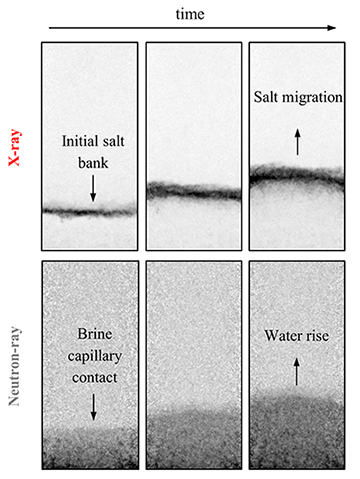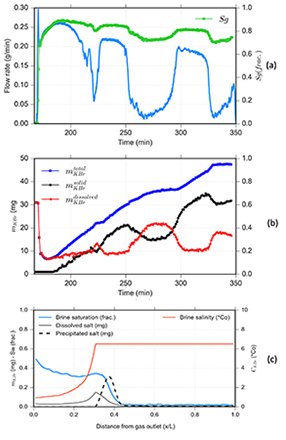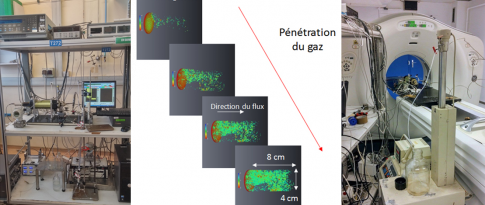Salt precipitation in permeable rocks is a risk faced by some energy sectors, particularly for gas storage in geological formations during operational phases (injection and extraction), when there is contact with saline aquifers. This is because the circulation of a gas phase in a partially brine-saturated porous medium induces salt crystallization and precipitation within the porous space. This precipitation reduces the space where fluids can circulate, altering rock permeability, or even leading to plugging under certain conditions.
In order to understand the underlying mechanisms behind this damaging phenomenon, experiments examining gas flow in a brine-saturated porous medium were conducted on IFPEN’s CAL-X flow test bench[1]. These experiments made it possible to observe the dynamics of salt migration in 2D, through X-ray radiography. However, the use of X-rays alone is not sufficient to both measure local water saturation and differentiate the states in which the salt is found.
To overcome this limitation, these experiments were replicated on the D50T neutron line at the Laue-Langevin Institute (UGA-77 proposal)[2], within the framework of a partnership with the NeXT-Grenoble laboratory[3] and Equinor. This line also has an X-ray source, thereby making it possible to simultaneously produce X-ray imaging and neutron imaging observations. The complementary nature of these two methods thus makes it possible to monitor local water saturation and salt quantity, both dissolved and precipitated.
Figure 1 shows a series of neutron and X-ray radiographies during the injection of a dry gas (N2) into a rock, in contact with brine at 100 g/l of KBr in its lower part. The neutron radiography clearly shows the presence of water at the base of the sample, while the X-ray radiography reveals salt migration.
Figure 2 illustrates the evolution over time (a) and space (b) of different magnitudes of interest (quantity of water, dissolved salt and precipitated salt). These observations have shown that salt precipitation results from the interaction of different parameters, i.e., the pressure gradient, brine concentration, capillary forces and water vapor partial pressure. Moreover, observations reveal that the injection of dry gas systematically cause salt to precipitate but permeability alteration is only observed if capillary contact is maintained with the brine.
This experimental work led to the construction of a 2D flow model incorporating the various physical and physicochemical mechanisms observed. Once calibrated, the model demonstrated good experiment predictability on a laboratory scale. Researchers will be able to use this model as part of a parametric study, with the possibility of scaling up through well simulation.
Click on pictures to enlarge
Publications:
[1] O. Lopez, S. Youssef, A. Estublier, J. Alvestad et C. Weierholt Strandli. 3S Web Conf., 146 (2020) 03001. https://doi.org/10.1051/e3sconf/202014603001.
[2] M. Mascle, O. Lopez, H. Deschamps, L. Rennan, N. Lenoir, A.Tengattini et S. Youssef. Int. Sym. of the Society of Core virtual, SCA 2021-06.
[3] A. Tengattini, N. Lenoir, E. Andò, B. Giroud, D. Atkins, J. Beaucour et G. Viggiani. Nuclear Instruments and Methods in Physics Research Section. Volume 968, 2020. https://doi.org/10.1016/j.nima.2020.163939.
Scientific contact: souhail.youssef@ifpen.fr
You may also be interested in
A scientific visitor helps improve the monitoring of CO2 storage facilities
Over the past ten years, IFPEN has been conducting research on the geochemical monitoring of the geological storage of CO2, in order to gain a better understanding of th
Interactions between clay minerals and anionic surfactants
THESIS OF ARIANE SUZZONI
Interactions between clay minerals and anionic surfactants
THESIS OF ARIANE SUZZONI








